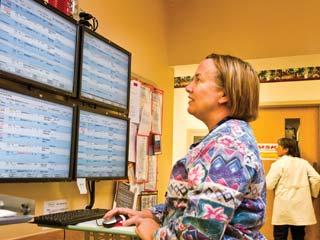
August 16, 2011 – The department of radiology at University of Utah HealthCare, along with Allocade Inc., will present new data highlighting effective, streamlined operational efficiencies through the use of artificial intelligence software. The performance improvement outcomes will be presented during the poster session at the Association for Medical Imaging Management (AHRA) 39th annual meeting and exposition in Grapevine, Texas, on Aug. 17, 2011.
The poster’s primary presenter is Steven Tew, MHA, MBA, manager of interventional radiology (IR) at the University of Utah Hospitals & Clinics. The session will focus on how the university’s IR services successfully reduced overtime costs by 90 percent; reduced FTE expenses by 10-15 percent; increased patient volume and improved its Press Ganey scores.
Tew will detail the benefits of managing daily operations in the digital world utilizing On-Cue, an artificial intelligence-based command and control system from Allocade. Streamlined communication among staff and caregivers, increased departmental and hospital efficiencies, increased patient satisfaction and improvements to the hospital’s bottom line are among the learning objectives of the session.
“Utilizing advances in healthcare information technology in combination with changes in departmental processes is necessary to increase efficiency, improve operational transparency between staff and physicians, and provide a higher quality of patient care,” said Tew. “New technology enables us to optimize schedules, streamline communication and provides us with real-time visibility, resulting in a significant reduction in patient scheduling delays, as well as an increase in throughput and improvements to our resource utilization.
“In addition, the software provides access to clinical operations data that previously was very difficult to obtain, enabling us to make objective, meaningful business decisions. As a result, we have preserved jobs and are improving our bottom line,” continued Tew.
In today’s digital world, parts of healthcare still operate in printed and hand-written paper. Prior to hospital patient procedures, forms are often filled out electronically – patients are scheduled using the radiology information system (RIS) and inpatients are ordered through the hospital information system (HIS).
On the day of the procedure, however, changes to scheduling due to emergencies or add-ons are handled by paper, phone calls and whiteboards. This results in delays, inefficient use of resources (both in equipment and personnel) and less patient-physician interaction.
The On-Cue system manages and communicates constantly changing patient logistics to improve daily operations for all modalities in the radiology department. This includes computed tomography (CT), magnetic resonance imaging (MRI), ultrasound, IR, nuclear medicine and X-ray.
Receiving information directly from the HIS and RIS, On-Cue utilizes artificial intelligence to prioritize among outpatient, inpatient and emergency department demands as it continuously optimizes operational schedules for available resources. The system delivers real-time visibility of all schedule changes to all interested personnel, thereby improving communication and coordination both inside the department and with other departments.
The theme for AHRA’s poster session is “performance improvement” and measurable outcomes are required.
For more information: www.allocade.com


 July 26, 2024
July 26, 2024 








